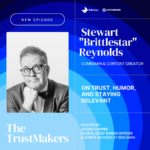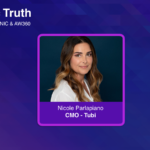Everyone in advertising has their stressful days, but few have the spectre of war hanging over their jobs. We recently caught up with Nickolas Rekeda, CMO of global native advertising platform MGID, who joined us from his home in Kyiv for a humbling discussion on the pressures of working when every day might be your last. Somehow undeterred, Rekeda still had time to talk shop about native advertising, the wider industry, and the forces shaping its future.
By R. Larsson, Advertising Week
Q: Perhaps MGID’s most remarkable feat is that it is a Ukrainian-founded company that has remained in operation throughout the Russian invasion. You’re in Kyiv at the moment; what’s it like working through wartime?
Right now, I’m in the city centre, a short walk from the government district. We’re shielded by air defence systems here, but they are not impenetrable. We live and work with the knowledge that at any time day or night, we might be killed by a rocket or a kamikaze drone. Work is often interrupted by power outages, and our sleep is interrupted by sirens. My first priority is making sure everyone in my team is ok.
Uncertainty has become the new normal for us. For Ukrainians, the war began in 2014. We were preparing for it to get worse and, eight years later, it did. Just before the war broke out in full force, many companies — especially global companies — relocated their employees for their safety. I’ve been in Kyiv, throughout, and at this point, there are vanishingly few legal ways for men to leave Ukraine. Not that I would; this is my home, this is where my family has planted our roots.
Q: MGID is a global company itself, with offices around the world. Did you ever consider relocating?
Some of our employees were transferred to other offices, but my team stayed in Kyiv. I’m their leader, so leaving was out of the question for me. You’ll often hear C-suite talking about leadership, but there’s no TED talk that can prepare you for leading during war; for keeping a team together when death is at their doorstep. But we have each other, and we stick together, adapting as humans always have. There’s yet to be a challenge we haven’t overcome, and we’re still fulfilling our customers’ needs and achieving our sales targets. These may seem like mundane concerns given the context, but feeling productive and accomplished keeps us going.
Q: If you don’t mind me asking, what has been the personal toll of the war?
It’s shocking, stressful, and strange. Are you familiar with the works of Erich Maria Remarque? He was a German writer who fought in World War One, best known for ‘All Quiet on the Western Front’. We’ve all read his novels, and they convey a true sense of what it’s like to live through war. Throughout our struggles and depression, we still go out to eat and drink — like Remarque’s characters — preserving our capacity for pleasure. This way, when we eventually return to the normal lives we hope for, our humanity will be intact.
Q: There’s no easy way to pivot to this subject, but we are here to talk about your work. MGID specialises in native advertising, what’s next for this channel?
Native advertising is having a moment in the spotlight. For me, it’s where all the positive trends in the open internet are coalescing. It’s privacy-friendly by design and built around interest and context rather than stereotypes and broad-brush demographics. That’s the direction the entire industry is moving in. The reliance on third-party cookies and personal data is declining, with good reason. Marketers want smarter, safer ways to reach people. It’s not just about who someone is on paper; it’s about how they interact with content, what patterns they follow, what they care about in that moment.
We’ve always believed in first-party data as a foundation, especially when it comes to addressability. Instead of targeting a “35-year-old male,” we target anonymous behaviours: what someone is reading, watching, engaging with. It’s a shift from static assumptions that become outdated the moment they are made to dynamic, real-time intent. That’s where native thrives. We’ve moved past blending ads into content being our USP. Now, it’s about relevance, timing, and user experience. That’s the future we’re building toward.
Q: The global economy seems to go from one shock to another, has this filtered through to digital advertising?
Absolutely. There’s no marketing team out there that hasn’t had to adapt their budget or strategy in real time, or — as is increasingly the case — in anticipation of future market shocks. The pressure is constant, and that’s changing how people think about performance. There’s less tolerance for waste, for guesswork. Everyone wants measurable outcomes, and they want them now. Even brands that typically go all-in on awareness are pivoting to performance channels.
This has spurred innovation in the performance space. Think back a few years ago, when attention-based metrics were considered niche. Today, they’re almost standard. Visibility isn’t enough, advertisers want proof that an ad was not only seen, but that it held attention and made an impact. These new signals are becoming table stakes, especially in reach and performance campaigns.
You can feel the urgency in the air. Budgets are tighter, expectations are higher, and everything is under the microscope. But, as they say, diamonds are made under pressure. This period of intensity has pushed the whole industry to think more creatively and adopt innovations that may have otherwise been left on the drawing board for years.
Q: AI has been a recent innovation bright spot in digital advertising. How has MGID leveraged the technology?
For us, AI isn’t a feature, it’s the engine of our company. Years before the current AI hype, we’ve been using machine learning to understand user behaviour and predict interest. What’s changed is how far we can go with it now. AI lets us dig deep beneath the surface layer — beyond demographics — and understand how people move through the funnel. What they’re reading, how long they engage, what nudges their actions. And it’s not just about the lower funnel anymore, where native typically thrives; AI helps us make an impact on the full consumer journey.
We may be machine learning veterans, but generative AI has been a huge learning curve, and in 2025 we’re really seeing the fruits of our investment. It’s changed how we create ads, how we refresh them, how we fight off fatigue. We built a tool called CTR Guard, which monitors campaign performance in real time. If it senses a drop — even a small one — it offers up to five new ready-to-launch creative variations. No guesswork, no opinions, just data-driven decision making. That’s the kind of rapid-fire support advertisers need in a market that moves this fast.











